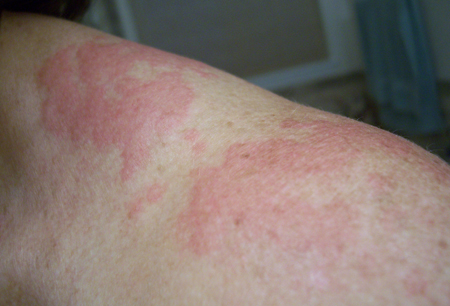History and exam
Key diagnostic factors
common
erythematous oedematous lesions
Urticaria typically presents with erythematous oedematous lesions that may be distributed on any part of the body. [Figure caption and citation for the preceding image starts]: Typical lesions seen in acute or chronic urticariaFrom the collection of Stephen Dreskin, MD, PhD [Citation ends].
pruritus
The lesions of urticaria are typically pruritic, although occasionally patients may report a painful or burning sensation.
resolution within 24 hours
Although episodes of urticaria can last for prolonged periods of time, individual lesions typically dissipate within 24 hours, leaving no residual markings.
swelling of face, tongue, or lips
Up to 40% of cases of urticaria have associated angio-oedema, which is swelling of the deeper layers of the subdermis.[37] This can affect any part of the body, but often occurs on the face, tongue, or lips, and demands prompt intervention as compromise of the airway can rapidly develop. [Figure caption and citation for the preceding image starts]: Angio-oedema of the lips in a patient who also has urticariaFrom the collection of Stephen Dreskin, MD, PhD [Citation ends].
Angio-oedema can also occur in the absence of urticaria, in which case potential diagnoses include drug-induced angio-oedema, hereditary angio-oedema, or acquired angio-oedema.
Other diagnostic factors
common
blanching lesions
Urticarial lesions blanch when palpated. Non-blanching lesions should raise suspicion for urticarial vasculitis.
uncommon
stridor
This may occur if the patient has severe laryngeal angio-oedema, and is a sign of impending airway obstruction due to oedema of the tongue.
Risk factors
strong
positive family history
This is applicable to many cases of hereditary angio-oedema, but not for urticaria or acquired angio-oedema. However, it should also be noted that 25% of cases of hereditary angio-oedema have no previous family history and are thought to be due to new mutations.[18]
exposure to drug trigger
Many cases of acute urticaria are allergic in nature and caused by an IgE-mediated reaction, although a non-IgE mechanism can also be responsible (e.g., direct mast cell activation, complement-mediated). A wide range of drugs can be involved, including antibiotics, cardiovascular drugs (e.g., amiodarone, procainamide), immunotherapeutics, vaccines, chemotherapy (e.g., bleomycin, cisplatin, fluorouracil), ACE inhibitors, calcium-channel blockers, and various drugs that can cause non-specific histamine release (e.g., non-steroidal anti-inflammatory drugs [NSAIDs], opioids, succinylcholine, amfetamines, hydralazine, radiographic contrast media).
exposure to food trigger
Many cases of acute urticaria are allergic in nature and caused by an IgE-mediated reaction. Any food has the potential to induce urticaria, but eggs, nuts, and shellfish are particularly common triggers.
recent viral infection
A common cause of urticaria in children. Acts via non-IgE-mediated mechanisms.
recent insect bite or sting
Urticaria is a common reaction to many insect bites and stings. It is more common in children than in adults.
weak
female sex
In both acute and chronic urticaria, women are affected more often than men (in a ratio of 2:1).[3]
Use of this content is subject to our disclaimer